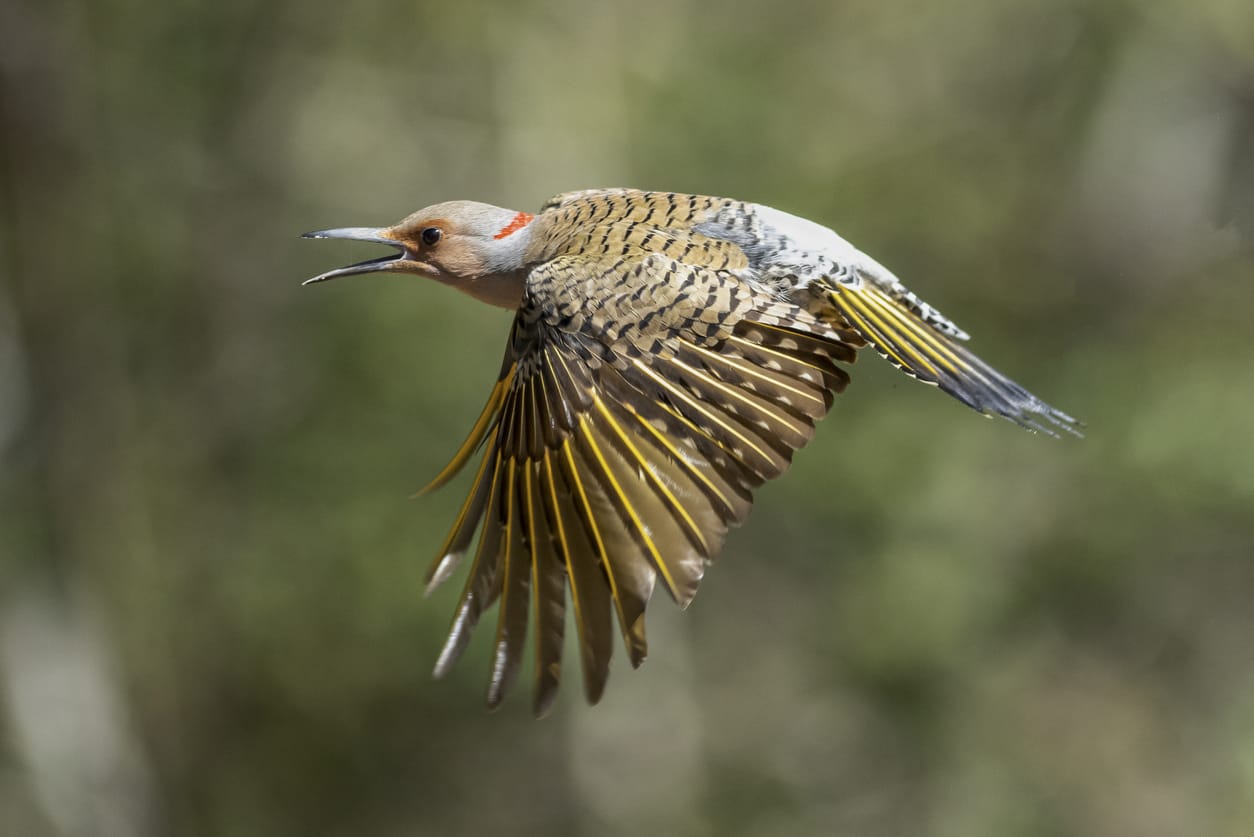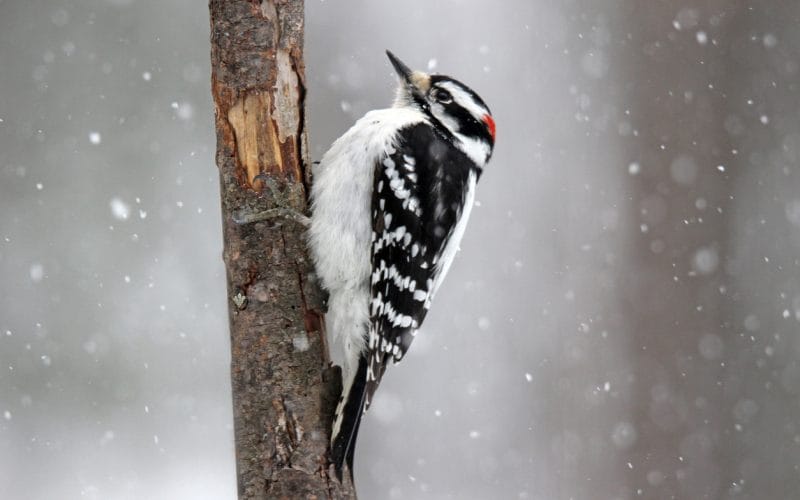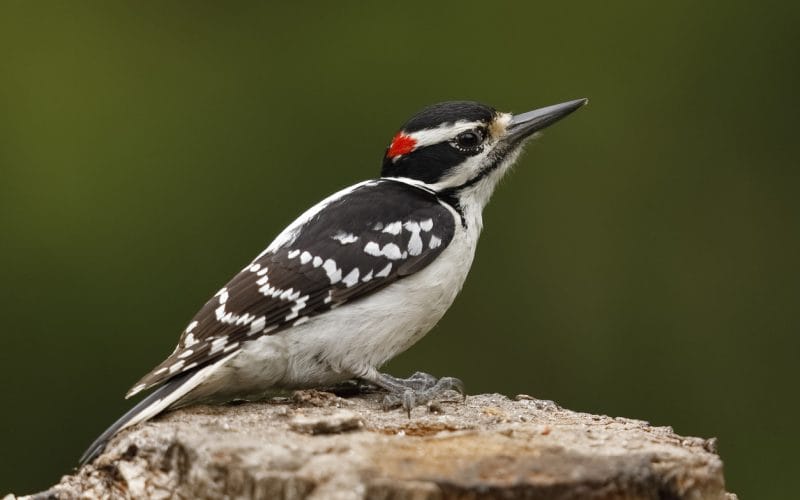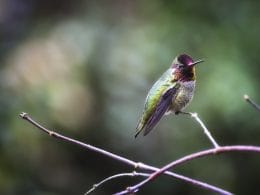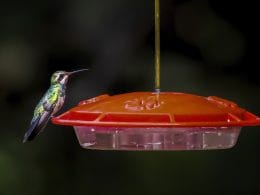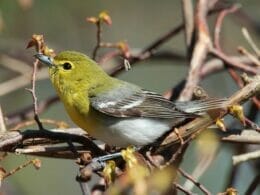Located in the Southeast region of the United States, Alabama has a moderate climate. In the summer, the state has high temperatures and humidity levels. The severity of Alabama’s winter conditions is dependent on whether you’re close to, or far from, the mountains.
Alabama’s location and climate make it a hotbed for diverse wildlife, including woodpeckers
We are here to guide you through the identification and some interesting facts about the species of woodpeckers in Alabama.
We’ll also give you pointers on how to attract some of these birds to your backyard.
9 Types of Woodpeckers in Alabama
Species of woodpeckers in a certain area/region can be classified as common or rare. There are 7 common Woodpecker species and two species that are rare. Those species are the Red-cockaded and Ivory-billed Woodpeckers.
Overall, there are 9 Woodpecker species with recorded sightings in Alabama.
- Northern Flicker
- Pileated Woodpecker
- Downy Woodpecker
- Hairy Woodpecker
- Red-bellied Woodpecker
- Red-headed Woodpecker
- Yellow-bellied Sapsucker
- Red-cockaded Woodpecker
- Ivory-billed Woodpecker
Common Woodpeckers in Alabama
Let’s get into it! Here are some interesting facts about the species of Woodpeckers you’re most likely to see in Alabama.
1. Northern Flicker

- Scientific name: Colaptes auratus
- Length: 11-12.2 In
- Weight: 3.9-5.6 oz
- Wingspan: 16.5-20.1 In
Northern Flickers can be sighted in Alabama all year round, however, you’re more likely to spot them during the colder winter months.
Author Note: These birds are of considerable size, they are characterized by their multicolored feathers with black spots. The males of this species also have crimson necks.
The aesthetic of Northern Flickers’ wings and tails depends on where their origins are. Those originating in the east have wings and tails with splashes of yellow. On the other hand, those from the west have splashes of red.
The Northern Flicker’s call can be described as a loud, piercing yelp. They craft their nests in tree cavities and typically lay 5-8 white eggs at a time.
Their diet is primarily composed of small insects, fruits, and seeds that they dig up from the ground with their curved bills.
You’re most likely to lay eyes on these birds at ground level in woods, forests, suburbs, and parks.
Northern Flickers aren’t as attracted to bird feeders as most other birds. So if you’re trying to get them to visit your backyard, make sure to add a birdbath and/or a nest box.
2. Pileated Woodpecker

- Scientific name: Dryocopus pileatus
- Length: 15.8-19.3 In
- Weight: 8.8-12.3 oz
- Wingspan: 26-29.5 In
Similarly sized to crows, the Pileated Woodpecker is the largest species you’ll see in the state. Sightings of this bird in Alabama are equally likely at any time of the year.
Pileated Woodpeckers are predominantly black in color, embellished with a white stripe. They also have a red stripe on their cheek. When airborne, the white portion of their wings becomes visible.
While most species of woodpecker can be sighted in the open, the same is not true for the Pileated woodpecker. It seldom frequents urban areas and can mostly be found in old forests that have many dead trees where these birds nest.
There are a couple of tell-tale signs that a Pileated Woodpecker is nearby. The first sign is the trademark rectangular cavities they make in trees. The other sign to look out for is their calling and drumming sounds, which are shrill and deep respectively.
These birds typically feed on insects such as termites, beetle larvae, and carpenter ants. They also eat berries and nuts.
This species is commonly misidentified as the Ivory-billed woodpecker (which will be covered later in this article). What sets the Pileated Woodpecker apart is its smaller size, as well as its grey bill.
3. Downy Woodpecker
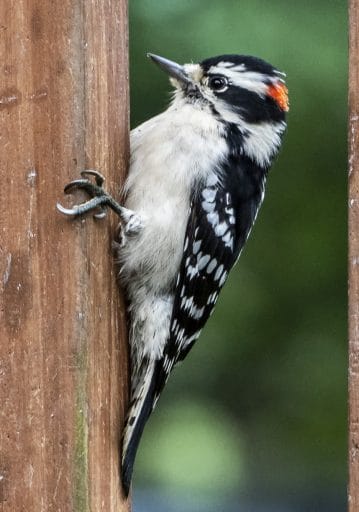
- Scientific name: Dryobates pubescens
- Length: 5.5-6.7 In
- Weight: 0.7-1.0 oz
- Wingspan: 9.8-11.8 In
Downy Woodpeckers are another species that can be sighted in Alabama at any time during the year.
Their dominant hue is black, with distinctive white and red patches on their backs and the backs of their heads respectively.
Author Note: Many bird enthusiasts find it hard to distinguish between Downy and Hairy Woodpeckers. The main thing to look out for is their overall size as well as the size of their bills. The Downy Woodpecker is two-thirds the size of Hairy Woodpeckers, it also has a smaller bill.
If you have a bird feeder in your backyard, chances are that these birds will be your most frequent visitor. You’ll hear them coming from their high-pitched calling sounds, and their high activity makes them a treat to watch.
Other places where you’re likely to see Downy Woodpeckers are open woodlands, orchards, and parks.
These birds build their nests in crevices they find in dead trees, and they typically feed on berries, acorns, and insect larvae.
4. Hairy Woodpecker

- Scientific name: Dryobates villosus
- Length: 7.1-10.2 In
- Weight: 1.4-3.4 oz
- Wingspan: 13-16.1 In
Although they’re also sighted in Alabama throughout the entire year, Hairy Woodpeckers aren’t as frequently seen as the species mentioned so far.
These birds are moderate in size and bear a striking resemblance to Downy Woodpeckers, not only in aesthetics but also in nesting behavior.
The white patch on their backs and the red one on their necks make them easily mistaken for Downy Woodpeckers. Also, their affinity for bird feeders and the fact that they also nest in the cavities of dead trees make it even more difficult to tell these two species apart.
The key distinguishing factor is Hairy Woodpeckers’ larger bills.
Top Tip: You’re most likely to see these birds perched on the thickest branches of big trees, as well as in parks and cemeteries.
Hairy Woodpeckers’ primary source of nutrition is insects. They feed on ants and beetle larvae, as well as larger insects such as spiders, millipedes, and bees.
5. Red-bellied Woodpecker

- Scientific name: Melanerpes carolinus
- Length: 9.4 In
- Weight: 2-3.2 oz
- Wingspan: 13-16.5 In
Red-bellied Woodpeckers are a common sight in Alabama all year long.
The tops of their heads are red (only in males), and so is their belly (hence their moniker). However, the redness of their bellies is of a lighter shade. This makes it hard to see, making the black and white splashes on their backs a better way to identify these birds.
Red-bellied Woodpeckers are often confused with Red-headed Woodpeckers due to their crimson crown. The key difference between these two birds is their size, with Red-bellied Woodpeckers being significantly smaller in size.
These birds can typically be found in woodlands, forests, and bird feeders. Keep your ears open for their booming calls, as they’re a telling sign that they’re nearby.
Their diet is primarily composed of spiders, insects, seeds, fruits, and nuts. They have long, spiked tongues and super sticky saliva. They use this to catch spiders and insects in hard-to-reach places.
If you’re trying to attract these birds to your backyard, make sure to have a suet feeder installed, as well as plenty of native berry trees (such as hawthorn) planted.
6. Red-headed Woodpecker
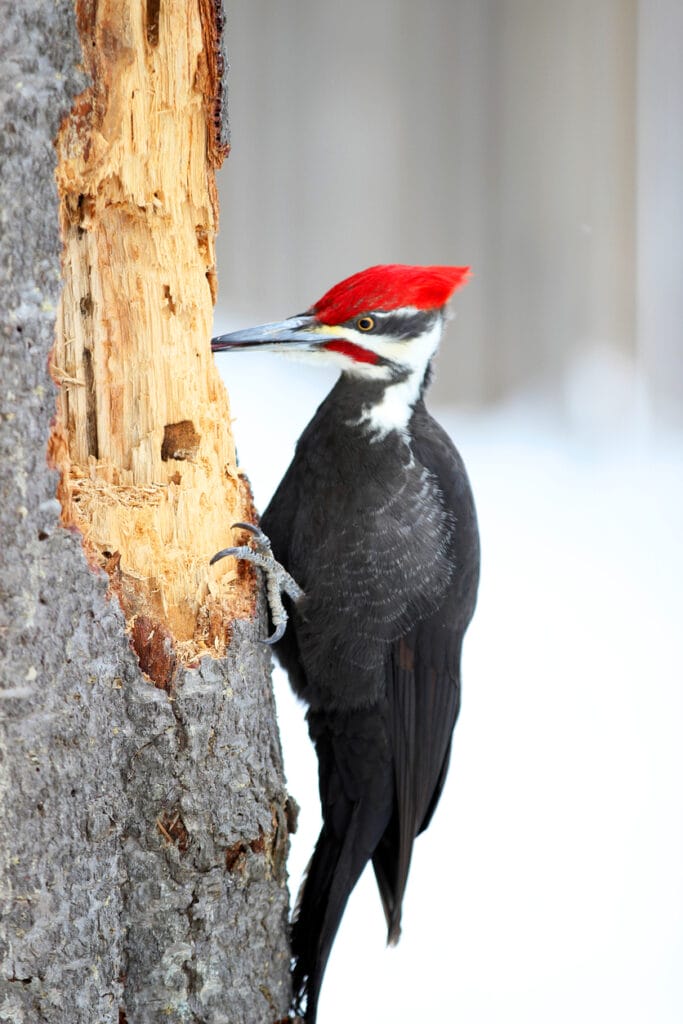
- Scientific name: Melanerpes erythrocephalus
- Length: 7.5-9.1 In
- Weight: 2-3.2 oz
- Wingspan: 16.5 In
Red-headed Woodpeckers are less frequently sighted in Alabama than most species in this list. However, they can still be seen in the state year-round.
As their name suggests, these birds have vibrant red heads. That, combined with the bold black and white colorations on their backs and wings respectively make this species an easy one to pin-point. Red-headed Woodpeckers also have white bellies and small tails.
Although moderately sized, these birds have bills that are as strong as those of their larger counterparts.
You’re most likely to spot a Red-headed Woodpecker in the vicinity of farms, open woodlands, and pine savannas. You can also find them perched on dead wood floating across a swamp. They do come to bird feeders in backyards, but this doesn’t happen that often.
This species is incredibly territorial in nature, and this is manifested in its aggressive behavior should any other bird try to encroach on their territory. They’ve been seen to destroy the eggs of other birds, and this is just one example of how serious they take guarding their territory.
Unlike the majority of species on this list, the Red-headed Woodpeckers’ diet is mainly plant-based. They use insects such as beetles and bees as merely supplemental nutrition. The majority of these birds’ nutrients come from berries, seeds, and nuts.
Due to deforestation, these birds have lost a large chunk of their habitats. This has led to the population of these fascinating birds taking a 70% dip over the last 50 years.
7. Yellow-bellied Sapsucker
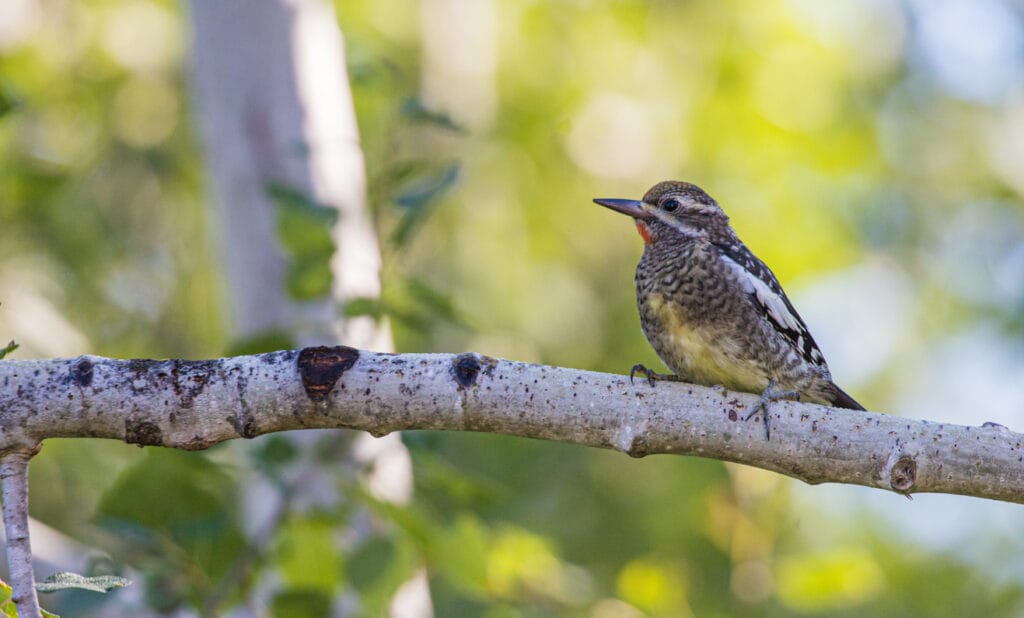
- Scientific name: Sphyrapicus varius
- Length: 7.1-8.7 In
- Weight: 1.5-1.9 oz
- Wingspan: 13.4-15.8 In
Yellow-bellied Sapsuckers are most commonly seen in Alabama during the winter months. When May comes around, they migrate to Canada and the Northeastern states of the US to breed.
Similarly sized to robins, these birds are quite small. As for their aesthetic, they’re mainly black in color. Both males and females of the species have red foreheads, however, males also have a crimson throat.
As per their moniker, these birds feed almost exclusively on tree sap. Making them most frequently found in sap-rich trees such as birch, hickory, and maple. They use their bills to poke holes in trees and extract the sap using their specialized brush-tipped tongues.
Author Note: The way these birds feed is actually quite fascinating. They make organized rows of holes in a tree, and meticulously maintain those holes to keep the sap flowing.
Your best bet in attracting these birds to your backyard is having suet feeders installed.
Rare Woodpecker Species
These species are seldom seen in Alabama. If you see one, you should count yourself lucky, as these birds are considered endangered species.
8. Red-cockaded Woodpecker
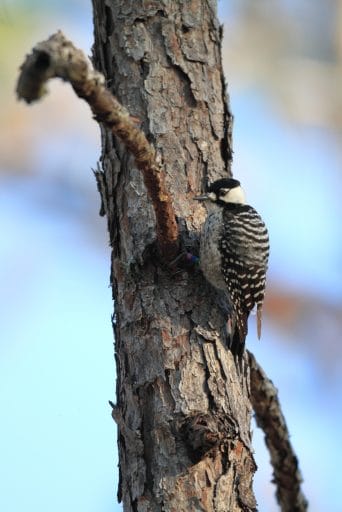
- Scientific name: Dryobates borealis
- Length: 7.9-9.1 In
- Weight: 1.5-1.8 oz
- Wingspan: 14.2 In
Red-cockaded Woodpeckers are an incredibly rare sight in Alabama. The only recorded sightings were in the Talladega and Conecuh National Forests.
The rarity of these birds’ sightings is due to their unfortunate classification as an endangered species. The cutting down of pine trees over the last half-century has deprived Red-cockaded Woodpeckers of their habitat. This has resulted in an almost 90% decrease in their population.
These birds are very small in size as well as in number, making them incredibly difficult to spot. They are characterized by their black and white striped backs and the white patches on their cheeks.
Red-cockaded Woodpeckers mainly feed on insects and their larvae. They’re most commonly known to eat centipedes, beetles, and ants. They supplement their diets with seeds and fruit.
These birds nest in pine trees and have the intriguing defense mechanism of drilling holes in trees. Potential predators are discouraged from approaching when they see sap leaking from such holes.
9. Ivory-billed Woodpecker
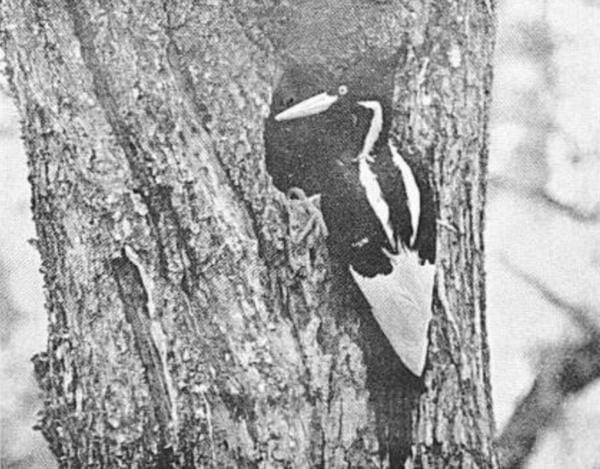
- Scientific name: Campephilus principalis
- Length: 18.1-20.1 In
- Weight: 15.9-20.1 oz
- Wingspan: 29.9-31.5 In
Ivory-billed Woodpeckers are another species that you’re highly unlikely to get the pleasure of laying eyes upon. These birds only have a trio of recorded sightings in Alabama.
Identifying these birds can be done by observing their wings and bills. Their bills have a unique ivory hue, and their wings are striped in white on the bottom and embellished with a conspicuous white patch on the top.
Top Tip: Ivory-billed Woodpeckers are sometimes mistaken for Pileated Woodpeckers. As mentioned before, the key difference lies in their larger size.
Sadly, these fascinating creatures are regarded as critically endangered. Not only that, but the process of declaring them fully extinct has been initiated since there have been no recorded sightings of them since 1944.
Conclusion
Out of the nine woodpecker species we have outlined, six are common sights in the state of Alabama.
However, if you’re lucky and happen to be at the right place at the right time, you might catch a glimpse of other species such as the Red-cockaded. This woodpecker is seldom seen in Alabama (or anywhere for that matter), but it has been sighted in the state before.
If you wish to boost the likelihood of woodpeckers visiting your backyard, installing suet feeders and having native berry plants in your garden is a must.
FAQ
Red-bellied and Yellow-bellied Sapsuckers are probably the most common across Alabama but as we stated above, there are 7 that you may be lucky enough to see.
Conecuh National Forest, Conecuh National Forest, Talladega National Forest, Cheaha State Park and Wheeler National Wildlife Refuge are good places to start looking for the Red-cockaded, Pileated and Red-headed Woodpeckers.
To find out where recent sightings of woodpecker have been, try eBird. You can search for the latest sightings or particular species or what has been seen in a certain area.




